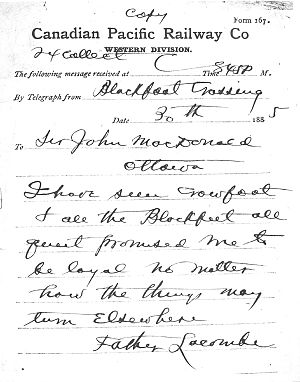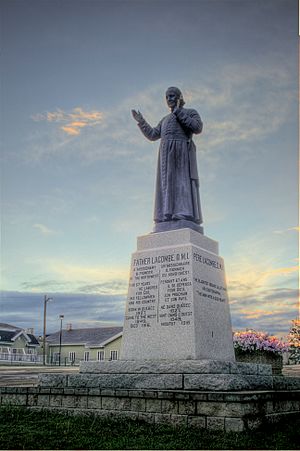Albert Lacombe facts for kids
Albert Lacombe (born February 28, 1827 – died December 12, 1916) was a French-Canadian Roman Catholic missionary. He is often called Father Lacombe in Alberta. He traveled and shared his faith with the Cree and Blackfoot First Nations in northwestern Canada.
Father Lacombe is remembered for several important things. He helped create peace between the Cree and Blackfoot peoples. He also helped the Canadian Pacific Railway build tracks through Blackfoot land. Plus, he convinced the Blackfoot leader Crowfoot not to join the North-West Rebellion in 1885.
Contents
Early Life and Becoming a Priest
Albert Lacombe was born in Saint-Sulpice, Lower Canada, on February 28, 1827. His parents were farmers, so he spent his early life on their farm. From a young age, he was very religious.
He studied at the Collège de l'Assomption. On June 13, 1849, at age 22, he became a priest. After becoming a priest, he went west to Pembina, Minnesota Territory. He worked there from 1849 to 1851 with another priest, Father George Belcourt. In 1851, he returned briefly to Canada East. He then worked as a curate in the town of Berthier.
Moving West and New Missions
Father Lacombe was not happy in Canada East. In 1852, he followed Monsignor Alexandre Taché to the Red River Colony. Later that year, Father Lacombe traveled to Fort Edmonton and Lac Ste. Anne. He spent the winter there with the Cree and Métis people.
During this time, he started learning the Cree language. He later helped translate the New Testament into Cree. He also helped write a Cree grammar and dictionary with another priest, Constantine Scollen.
From 1853 to 1861, Father Lacombe worked to expand the mission at Lac Ste. Anne. He wanted to build stronger ties with the Indigenous people. He traveled as far north as Lesser Slave Lake to meet more people. In 1855, he joined the Oblate order.
By 1861, Father Lacombe found that the Cree near Lac Ste. Anne were still living a nomadic lifestyle. This meant they moved from place to place. He wanted to find a better place for farming. So, in 1861, a new settlement was started along the Sturgeon River. This new place became Saint Albert, Rupert's Land.
Helping Peace and Building Railways
In 1864, Father Lacombe was given a new task. He was to share his faith with the Cree Plains Indians. From 1865 to 1872, he traveled widely across the prairies. During this time, he helped make peace between the Cree and the Blackfoot.
In 1872, Lacombe went to Fort Garry (now Winnipeg, Manitoba). He worked to encourage people to move to Manitoba. He traveled across eastern Canada and the United States for this purpose. In 1879, he became the Vicar of Saint Boniface, Manitoba. Around this time, he started working with the Canadian Pacific Railway. He also helped the workers, called navvies, who were building the railway.
One group of workers was Yellowhead and his Iroquois followers. They worked on the railway across Canada. After the railway reached the Rocky Mountains, Yellowhead asked Father Lacombe for help. He wanted to get land for his Iroquois followers. Father Lacombe helped arrange the Michel Reserve, land north of St. Albert, for them.
In 1882, Father Lacombe moved to Calgary. The Canadian Pacific Railway wanted to build tracks through Blackfoot territory. The Blackfoot people did not want this. Father Lacombe talked with the Blackfoot leader Crowfoot. He helped them agree that the railway could pass through Blackfoot land. Because of this, Crowfoot received a lifetime pass to ride the railway. Father Lacombe also received one.
When the North-West Rebellion started in 1885, Prime Minister Sir John A. Macdonald asked Father Lacombe for help. He wanted Father Lacombe to make sure the Blackfoot Indians stayed neutral. Even though some Cree warriors joined the fighting, Crowfoot kept his warriors out of the conflict. He believed the rebellion would not succeed. Father Lacombe later wrote a book about Crowfoot after he died.
Later Life and Legacy
For the rest of his life, Father Lacombe helped start schools across Western Canada. One example is St Mary's School in what is now the Mission District of Calgary. His last big trips were to Europe in 1900 and 1904. He visited Austria and met Emperor Franz Joseph I. He also traveled to Galicia (now parts of Poland and Ukraine). He encouraged people from there to settle in Canada.
Father Lacombe died in 1916 in Midnapore, Alberta. Midnapore is now a part of Calgary. His body was buried in the church in St. Albert. He had served St. Patrick's Church in Midnapore from 1904 until his death.
What He Left Behind
Many places and things are named after Father Lacombe. A high school in Calgary, Father Lacombe High School, was named for him in 1979. An elementary school in St. Albert, Alberta, Albert Lacombe, also carries his name. The cities of Lacombe, Alberta, and St. Albert, Alberta, are named in his honor too.
In 1932, the Canadian government recognized Lacombe as a National Historic Person. A special plaque about this is on Highway 36 near Brosseau, Alberta. Also in 1932, his work with the Blackfoot and John McDougall's work with the Cree were recognized. They both helped keep peace in 1885. A plaque for this can be found in Wetaskiwin, Alberta.
Film Appearance
Actor John Hamilton played Father Lacombe in a small role. This was in the 1949 Hollywood movie Canadian Pacific.




